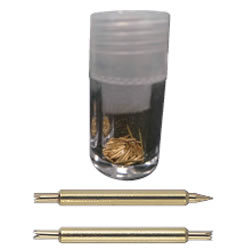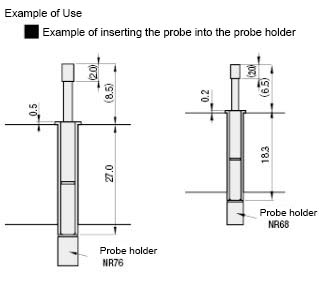(!)NOTE : Windows 7 users won’t be able to use some latest features of eCatalog/WOS since Microsoft is ending support for Windows 7 on 14 Jan, 2020. Please upgrade your system for uninterrupted services.
- Notice of End of Sales for Economy Series Pneumatic Equipment Category. More information.
Specification/Dimensions
-
Plunger Tip Shape (Both Ends Type)
- J1 (L) / J (R)
- J1 (L) / U (R)
- B (L) / B (R)
- B (L) / J (R)
- B (L) / U (R)
-
type
- RNPA038
-
CAD
- 2D
- 3D
Days to Ship
-
- All
- 10 Day(s) or Less
Specify Alterations
RNPA038 Series Double Tipped Contact Probes, Min Pitch0.5mm 【50 Pieces Per Package】

- Volume Discount
Copy Part Number URL to Clipboard
The part number URL has been copied into your clipboard.-
- Order Qty :
-
-
- Total Price :
- ---
-
- Days to ship :
- ---
Select part number to Order Now/ Add to Cart
Product Description
New at MISUMI? Get 20% Discount on your First Purchase. Click to Register Now
Economy RNPA038 Series Double Tipped Contact Probes
- RNPA Probes with Nickel and Gold Plating for Reliable Performance.
- Just 0.5mm Pitch for Dense and High-Performance Applications.
- Cost-Effective Excellence – Economical Pricing without Compromising Quality.
- Enjoy up to 100,000 uses with consistent performance.
- Low resistance for superior signal transmission.


![]()
MISUMI Standard
![]()
Cheaper Price
![]()
Product Variety
![]()
3D CAD Support
Product Overview of Contact Probes
Overview of Contact ProbesContact Probes is a contact medium for electrical testing, and a high-end precision electronic hardware component.
It can be used to check the conductivity of all electronic circuits.
Product Feature of Contact Probes
Dimensional Drawing of Contact Probes



Example Use of Contact Probes

Precautions of Contact Probes
■General environmental conditions of Contact Probes
· Operating ambient temperature is 10 to 40 degrees, humidity is 30% below
· Surrounding environment: An environment where there is no dust, corrosive gas, oil, etc. so that the probe is not polluted.
■Stroke condition
· Please apply axial load only, not transverse load.
· Exceeding the specified stroke (2/3 of the full stroke) will significantly reduce the life of the probe.
· The probe life may be shortened if moving at a speed of more than 60 times /min (constant speed).
■Current application condition
· Please apply current in a static state and in contact with the target contact within the specified stroke.
· The probe life may be significantly reduced if current is applied during operation within the specified stroke, outside the specified stroke, or without contact with the target contact (open circuit).
· The probe may not meet the maximum allowable current listed in the catalog due to aging and other reasons. Please design to ensure there is enough margin in actual use.
■Voltage application condition
· Please apply voltage in a static state and in contact with the target contact within the specified stroke.
· Do not apply voltage without contact with the target contact (open circuit). Otherwise, it will cause electric discharge when it is about to be touched, causing damage to the probe.
· When applying high voltage to the probe, please strictly observe the application conditions of current and voltage, and pay attention to avoid discharge phenomenon and instantaneous huge current generated during discharge.
■Maximum allowable current
· The maximum allowable current listed in the product catalog is the maximum value of continuous current flowing within 1 minute under the above-mentioned conditions (general environment, stroke, application of current and voltage).
■Contact resistance of Contact Probes
· The resistance value listed in the product catalog refers to the representative value measured by applying a current of 10 mA to the probe and making it contact with the pure silver terminal under the above-mentioned conditions (general environment, stroke, application of current and voltage).
· If the flowing current is too large, the resistance may increase due to the internal aging of the contact or probe.
· After repeated operations within the specified stroke, the resistance may increase due to the aging of the contact or probe.
■Reference number of replacements
· The reference number of replacements listed in the product catalog refers to the reference number for probes that can be used normally when the current is 10mA under the above conditions (general environment, stroke, application of current and voltage).
· When the resistance increases or the spring pressure decreases due to the difference in the operating environment and conditions, the probe may need to be replaced before the reference number is reached. Please replace it in time according to actual usage.
■Spring pressure
· If the probe temperature exceeds 80 ℃, the spring pressure will drop.
· If the current value is increased, the spring pressure may drop due to the heating of the probe.
■Mounting hole size for press-fit (reference)
· Reference value only, depending on the material and thickness of the resin plate. Please design referring to the size of the probe holder press-fit part.
Usage Method of Contact Probes
Please select the product according to the mounting pitch (spacing) of the workpiece to be inspected.
Also, select the probe holder corresponding to the probe.
* The probe is different from the probe holder mounted directly on the resin plate, can be easily disassembled, saving time to replace the probe.
●About the use of the Contact Probes (probe holder)
① Insert the probe holder after opening holes on the resin plate (bakelite board, etc.). (See Diagram 1)
* For the opening size, please refer to the mounting hole size for press-fit as documented on each page. (See Diagram 2)
* If there is clearance between the resin plate and the probe holder, please fix it with adhesive before using it.
② After installation, wire to the probe holder.
* When soldering wires, please be careful not to let the flux flow into the probe holder. Otherwise, the probe may not work.
* Depending on the environment, if there is no space for soldering or wiring, please perform wiring before press-fit.
③ Insert the probe into the probe holder. (Refer to Diagram 1)
* At this time, if the tip (plunger) part is pressed down forcefully, it may cause damage or deterioration in function. Please be careful.
* Please use within the prescribed stroke (2/3 of the full stroke).

Related Products of Contact Probes

Specification Table of Contact Probes
 to
to  .
.Part Number of Contact Probes ( Type· Type· No.) No.) | - |  L L R R |
| RNPA038 | - | J1U |
 When ordering, specify the number of boxes.
When ordering, specify the number of boxes.Order quantity 1 means purchasing 1 box (50 pcs).
| Part Number | Tip Shape | Mounting Pitch (min) | Full stroke (Rated stroke) | Spring pressure (Rated stroke) | Maximum Allowable Current | Resistance | Reference of replacement number of use | ||
 Type Type |  No. No. |  L (Left) |  R (Right) | ||||||
| RNPA | 038 | B | U J B | 19.7mil/0.5mm | 1.1mm (0.65mm) | 30±6gf | 0.5A | 100mΩ | 100,000 times |
| J1 | U J | ||||||||
Part Number
- Incomplete part number.
Please use left hand selections to complete a part number.
| Part Number |
|---|
| RNPA038-BB |
| RNPA038-BJ |
| RNPA038-BU |
| RNPA038-J1J |
| RNPA038-J1U |
| Part Number | Price | Minimum Order Qty. | Number of pc(s). included in pkg. | Volume Discount | Days to Ship | Plunger Tip Shape (Both Ends Type) |
|---|---|---|---|---|---|---|
₹ 6,249.05 | 1 Pack(s) | 50 Pieces Per Package | Available | 10 Day(s) | B (L) / B (R) | |
₹ 6,249.04 | 1 Pack(s) | 50 Pieces Per Package | Available | 10 Day(s) | B (L) / J (R) | |
₹ 6,246.28 | 1 Pack(s) | 50 Pieces Per Package | Available | 10 Day(s) | B (L) / U (R) | |
₹ 6,249.05 | 1 Pack(s) | 50 Pieces Per Package | Available | 10 Day(s) | J1 (L) / J (R) | |
₹ 6,249.05 | 1 Pack(s) | 50 Pieces Per Package | Available | 10 Day(s) | J1 (L) / U (R) |
Loading...
Basic Information
| Type | Double Tipped Probe | Min. Mounting Pitch(mm) | 0.5 | Full Stroke (Range)(mm) | 1~2.6 |
|---|---|---|---|---|---|
| Full Stroke(mm) | 1.1 | 2/3 Stroke Spring Pressure (Range)(gf) | 0~30 | Plunger Material | BeCu |
| Plunger O.D.(Ø) | 0.2 | Plunger Surface Treatment | Gold Plating on Nickel Undercoat | Plunger Length L1 (Range)(mm) | 0.1~3 |
| Barrel, Receptacle Material | Phosphor Bronze | Barrel, Receptacle O.D.(Ø) | 0.38 | Properties | Standard |
| Allowable Current(A) | 0.5 | Resistance(mΩ) | 100 | Plunger Length(mm) | 0.6 (L) / 1.1 (R) |
| Barrel, Receptacle Length(mm) | 4 | 2/3 Stroke Spring Pressure(gf) | 30 |
- The specifications and dimensions of some parts may not be fully covered. For exact details, refer to manufacturer catalogs .
Frequently asked question (FAQ)
- Question: What are the operating environment conditions for probes?
- Answer: Ambient temperature is 10 to 40℃, humidity is below 30%, and there is no dust, corrosive gas, oil, etc., so that the probe is not polluted.
- Question: Does the center distance chosen for the probe refer to the center distance between two adjacent probes?
- Answer: Yes. If it is less than the minimum mounting pitch, the installation of two adjacent probes interferes with each other.
- Question: If I choose a non-lead type product, how to use it?
- Answer: The customer shall weld the wire by himself.
- Question: What are the main types of MISUMI probes?
- Answer: General probes, rotary type probes, integral type probes and double tipped probes.



How can we improve?
How can we improve?
Thank you for your time.
Your feedback is essential for our continuous improvement
Privacy Policy
Thank you for your cooperation.
Thank you for your time.
Your feedback is essential for our continuous improvement
Please use the inquiry form.
Privacy Policy